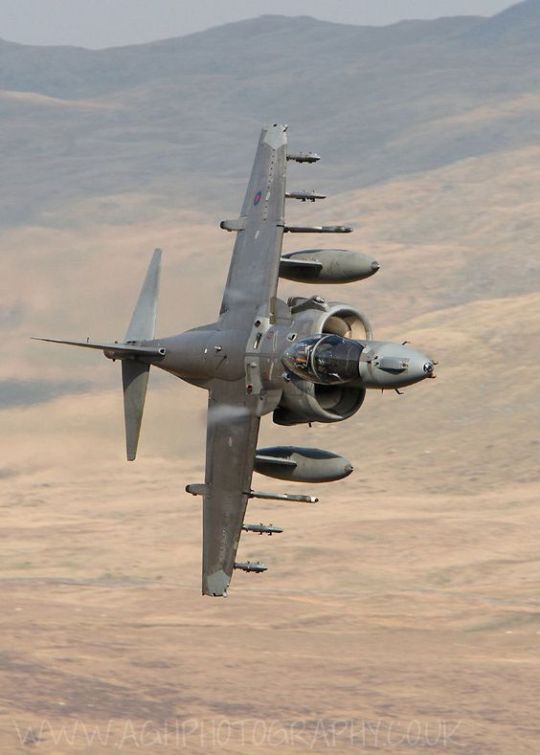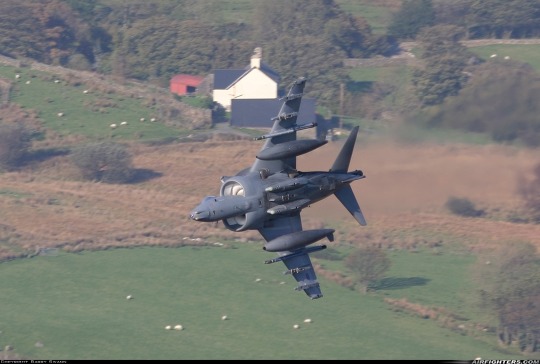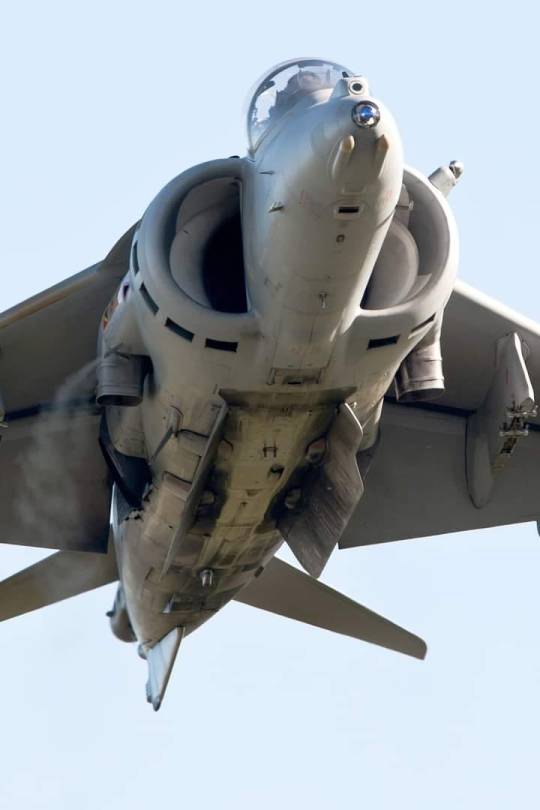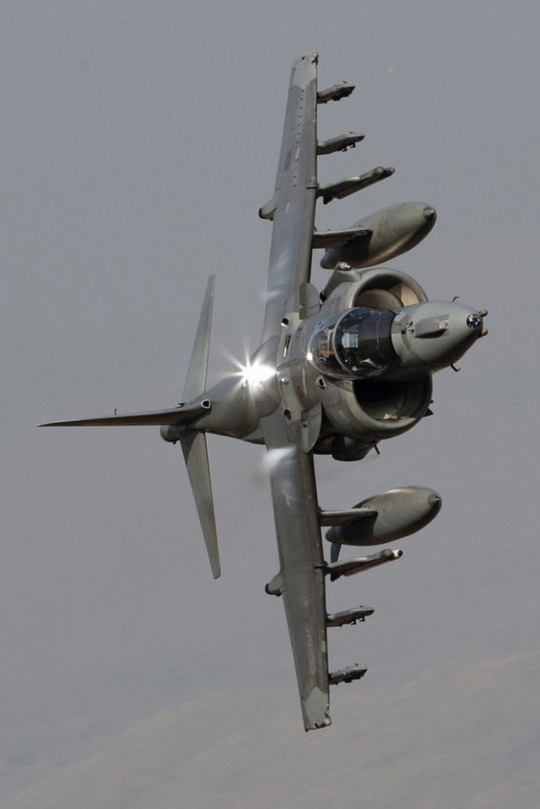#harrier gr9
Text
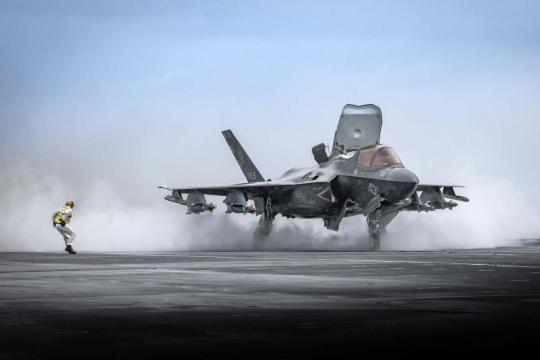
IMAGES: F-35B fighters in "beast mode" aboard HMS Prince of Wales
Fernando Valduga By Fernando Valduga 10/26/2023 - 11:00am in Military
On board the deck of the British aircraft carrier HMS Prince of Wales, on the east coast of the U.S., a fully loaded F-35B, to the fullest, is helping the Royal Navy's attack force develop Lightning capability.
The F-35 armed with the maximum capacity of weapons is known in aviation jargon as "bow mode": each pillar occupied by a weapon and the internal compartment of crowded bombs.

Fully charged, the F-35B can provide 22,000 pounds of destructive and defensive power: air-to-air and air-to-ground missiles and conventional and laser-guided bombs.
If you are trying to imagine a payload of 22,000 pounds... it is the equivalent of the heaviest bomb carried by a World War II Lancaster bomber (the Grand Slam or "earthquake" bomb).
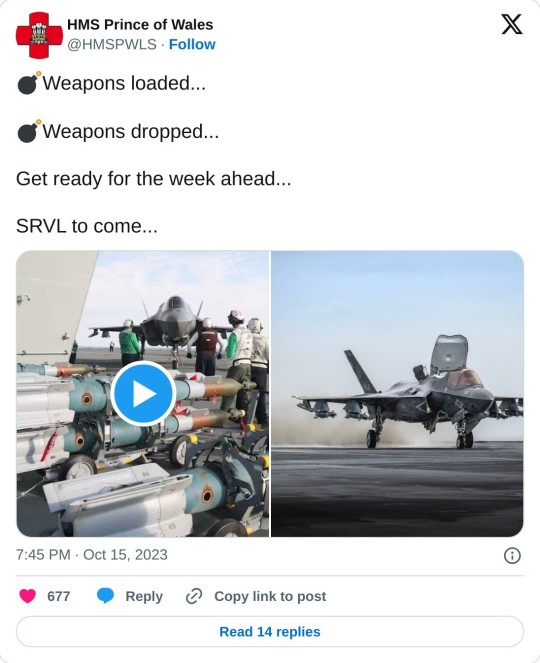
And it is almost three times more than the last attack plane embarked on a UK aircraft carrier, the Harrier GR9, more than a decade ago.
In this case, the specially modified F-35B of the U.S. Navy Integrated Test Force was loaded with a combination of 500-pound Paveway IV laser-guided inert bombs and 1,000-pound inert Paveways in the weapons compartment.

To date, the F-35 have detaculated from the 350-foot mark on deck (approximately aligned with the end of the front island).
Depending on a number of factors (including weather, wind on deck, humidity), a fully charged Lightning may need a full run to the ski jump to take off... which means starting all the way back at the 850-foot mark... not far from the rear end of the cockpit.
It is the first time that a complete preparation has been tested on any of the aircraft carriers. And it is also the first bomb (although inert, practical models) to be launched by aircraft launched from HMS Prince of Wales.

The Captain of Flight Deck Pet Officer 1 John Etherington - who has experience in deck operations on American Nimitz-class aircraft carriers - was the sailor who gave the authorization to the pilots.
"It was impressive to launch the jet, all full of bombs, from the back of the cockpit," he said. “It's exciting to see us pushing the boundaries of UK naval aviation.”
In control of the F-35 in beast mode were the pilots of the U.S. Marine Corps, Major Paul Gucwa, and Lieutenant Colonel Mike Lippert.

This is the fourth time the latter has worked with the UK aircraft carrier force - three times helping HMS Queen Elizabeth develop its Lightning capability, now with the Prince of Wales.
“It is a pleasure to see the continuous progress in operational capacity – there has been undeniable growth and progress,” he said.
“Major Gucwa and I had great pleasure in continuing to expand the combat capability of Britain's largest warship. We were a small part of an immense multifunctional and integrated team that covered every corner of the ship, the mission control rooms of the F-35 ITF and our worldwide partnership with the F-35 Lightning II - all focused on increasing the interoperability and lethality of our frontline fighter."
TAP TITLE BAR TO VIEW VIDEO ☝️
Then, the tests of the F-35 ship off the US will carry out continuous landings (instead of standard verticals), first without armaments, then with.
Tags: Military AviationHMS Prince of WalesLockheed Martin F-35B Lightning IIRN - Royal Navy/Royal Navy
Sharing
tweet
Fernando Valduga
Fernando Valduga
Aviation photographer and pilot since 1992, has participated in several events and air operations, such as Cruzex, AirVenture, Dayton Airshow and FIDAE. He has work published in specialized aviation magazines in Brazil and abroad. Uses Canon equipment during his photographic work in the world of aviation.
Related news
MILITARY
Poland receives new batch of South Korean FA-50 fighters
26/10/2023 - 08:59
MILITARY
After the A-10, the US deploys F-16 in the Middle East, but not yet the F-35
10/26/2023 - 08:43
Image of B-21 taxiing for the first time in Palmdale, posted on Reddit by user u/Mug_Of_Fire.
MILITARY
B-21 starts taxi tests in the last stage before the first flight
25/10/2023 - 19:47
The AARGM-ER is launched from a U.S. Navy F/A-18 during a successful real fire test at the Point Mugu Sea Test Range, California. (Photo: U.S. Navy)
ARMAMENTS
Finland will acquire AARGM-ER anti-radiation missiles
25/10/2023 - 17:00
HELICOPTERS
New British Army Apache helicopter passes the battlefield test
25/10/2023 - 16:00
MILITARY
L3 Harris FVR-90 fuselage stimulates prototype for U.S. Navy unmanned aircraft system
25/10/2023 - 14:00
Client PortalClient PortalClient PortalClient PortalClient PortalClient PortalClient PortalClient PortalhomeMain PageEditorialsINFORMATIONeventsCooperateSpecialitiesadvertiseabout
Cavok Brazil - Digital Tchê Web Creation
Commercial
Executive
Helicopters
HISTORY
Military
Brazilian Air Force
Space
Specialities
Cavok Brazil - Digital Tchê Web Creation
25 notes
·
View notes
Text


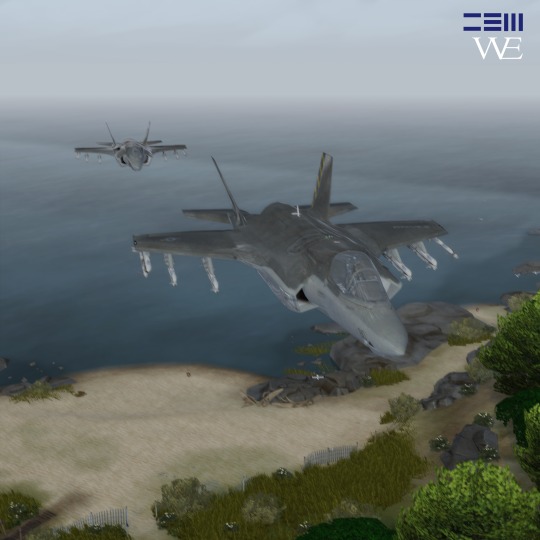
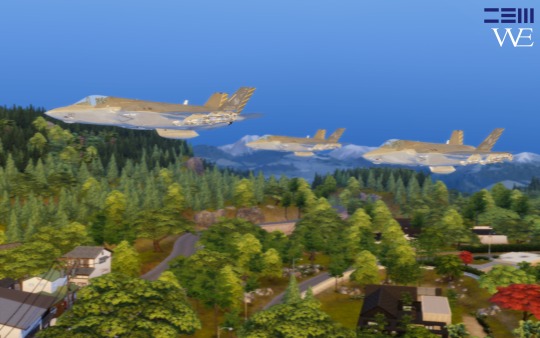


STOVL Fighters Collection
DOWNLOAD
At the end of 1950s, the engineers had just an idea of delivering the aircraft even without a runway. Then in the beginning of 1960s, some tests conducted to test the capability of STOVL (Short Take-Off Vertical Landing) or in other word, a possibility of vertical movement of the fixed-wing aircraft, began with the "Flying bunk" in1959. Then the Hawker Siddeley Limited in Britain proposed a concept named "P1127 Kestrel" as a prototype of the VTOL fighter. Then this concept acepted and in 1969, the production of Harrier GR1 had begun. This aircraft was intended to be in use for Royal Air Force, but the Royal Navy also got their own version of FRS1 years later. These Harriers sought it's first battle experience in Falklands War in 1982 when these Harriers brought down some of the Argentine's air capability without any losses. The last of the Harrier production was in GR9 variant which subsequently substituted by the latest F-35B by the Royal Air Force.
McDonnell-Douglas AV-8B Harrier II
The USMC was also seeking the aircraft that suits for the amphibious mission. After the success of the Harrier FRS1 and GR3 variants in the Falklands War, in 1985 the USMC proposed an inquiry to acquire some of these aircrafts, with also stated that these aircrafts should be manufactured in the United States. Then BAe Industries licensed the Harrier to the McDonnell-Douglas company . Also this aircraft met the service within the Royal Spanish Navy in 1987. Several missions has been done by AV-8Bs including Gulf War, Operation Enduring Freedom, Operation Iraqi Freedom and Libyan Crisis.
Lockheed Martin F-35B
The STOVL variant of F-35 Thunderbolt which it's STOVL technology derived from Yak-141 VTOL system, which sold to the Lockheed Martin in 1992, which emphasizes the vector exhaust and a fan in the middle of the aircraft. Also the most wanted aircraft in action of this century. The F-35B is the short take-off and vertical landing (STOVL) variant of the aircraft. Similar in size to the A variant, the B sacrifices about a third of the A variant's fuel volume to accommodate the SDLF. This variant is limited to 7 g. Unlike other variants, the F-35B has no landing hook. The "STOVL/HOOK" control instead engages conversion between normal and vertical flight.The F-35B is capable of Mach 1.6 (1,976 km/h) and can perform vertical and/or short take-off and landing (V/STOL)
#the sims 4#the sims#the sims 4 custom content#ts4 cc#ts4military#the sims 4 military#ts4#the sims 4 cc#ts4cc#deus ex machina#the sims 4 decades challenge#ts4 decades challenge#sims 4 decades#early 2000s#late 2000s#2000s style#fighter jet#f 35 lightning ii#british#american
27 notes
·
View notes
Photo
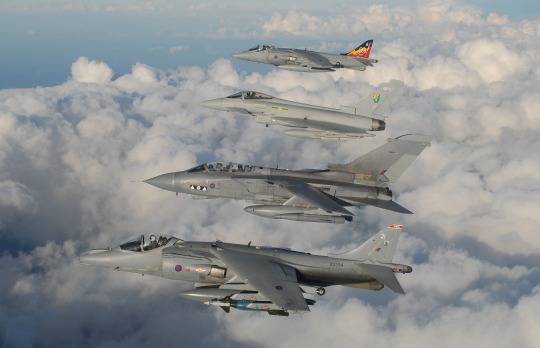
RAF 95th Anniversary Formation (2007)
#RAF#Military aircraft#Airplanes#Aviation#Combat jets#Harrier Gr9#Tornado GR4#Typhoon F2#Panavia#Eurofighter#Jump jet#Aircraft formation
54 notes
·
View notes
Text
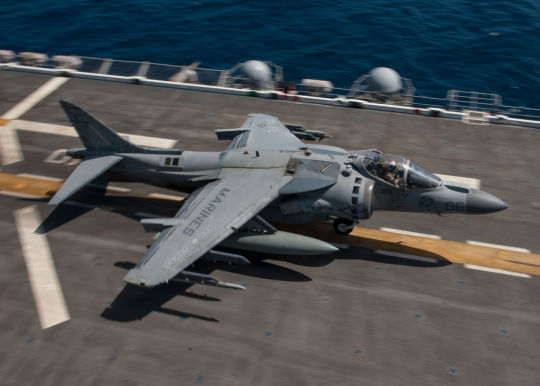
-An AV-8B from VMA-163 takes-off from USS Makin Island (LHD-8). | Photo: National Museum of the U.S. Navy
Flightline: 70 - McDonnell Douglas/BAe AV-8B Harrier II
The AV-8A was operated by the USMC beginning in 1971, but the Marines quickly found that the Harrier was less powerful than hoped, only capable (with a standar takeoff, no less) of carrying a smaller payload than an A-4 over a shorter range. In 1973, a joint US/UK team began work on a project to develop a new Harrier, powered by a redesigned Pegasus 15 engine. This aircraft, dubbed the AV-16, would have double the AV-8A’s range and payload, and would replace the Harrier GR.1/3 in RAF service and the AV-8A and A-4 Skyhawk in USMC roles. The UK pulled out of the project in 1975, owing to rising costs and decreased defense spending, and the US, unwilling to foot the costs alone, canceled the program. McDonnell Douglas and Hawker Siddeley continued work on upgrading the Harrier, and in 1976 began modifying two AV-8As with new wings, revised intakes and nozzles, and other aerodynamic changes. These mules were designated YAV-8B.

-One of two AV-8As being modified into YAV-8Bs. | Photo: U.S. Navy Naval Aviation News
The results showed greater than expected drag, but positive test results in other areas, including payload, range, and V/STOL performance, led to the award of a development contract in 1979. In 1981 BAe (formed by the nationalization and merger of British Aircraft Corporation, Hawker Siddeley Aviation, Hawker Siddeley Dynamics and Scottish Aviation) rejoined the program in 1981, enticed by the more affordable path McDonnell Douglas was forging. The MoU stipulated a 60/40 split between the US and UK companies, with airframe production taking place at McDonnell Douglas’ facilities in suburban St. Louis, Missouri, and BAe’s Kingston and Dunsfold facilities, and engine production split 75/25 between Rolls-Royce (which had previously absorbed Bristol Siddeley) and P&W.

-Illustration: McDonnell Douglas
The AV-8B Harrier II was extensively redesigned from the AV-8A, with the forward fuselage extended and the cockpit raised by ten inches, providing better pilot visibility. To compensate for these changes, the rear fuselage was lengthened by a foot and a half, and a taller tail, based on that used on the Sea Harrier, was fitted. The biggest change was the new supercritical wing, which was larger than the one used on previous models (the outriggers on the AV-8B are in the same place as on the AV-8A/GR.1/3, giving a sense of scale), and had a higher aspect ratio and decreased sweep. The new wing also had leading edge extensions, all of which grants the Harrier II a 6,700lb increase in payload with a 1,000' takeoff roll. The AV-8B was the first combat aircraft to feature carbon fiber composites in its construction, with the wing and forward fuselage being almost exclusively carbon/epoxy construction, leading to the Harrier II being almost five hundred pounds lighter than if it had been constructed from metals alone.

-An AV-8B from VMA-331 in 1991 during Operation DESERT STORM. The squadron eventually dropped 256 tons of ordinance during the war and became the first attack squadron to operate from an amphibious assault ship. | Photo: U.S. Navy National Museum of Naval Aviation
The AV-8B completed operational evaluation (OPEVAL) in 1985, and entered service with the USMC starting with USMC squadron VMA-331 (“Bumblebees”). In 1990 Marine Harrier IIs were deployed to the Persian Gulf on the amphibious assault ships USS Nassau and Tarawa as part of Operation DESERT SHIELD, flying training and support sorties. Despite plans to hold the AV-8B in reserve during the initial phases of DESERT STORM, Harriers were pressed into service on 17 January in response to a call for close air support from an USMC OV-10 Bronco against Iraqi artillery positions. The next day, AV-8s began strike missions against Iraqi targets in southern Kuwait. During Operations DESERT SHIELD and DESERT STORM, 86 AV-8Bs amassed 3,380 flights and about 4,100 flight hours, with a mission availability rate of over 90 percent. Five AV-8Bs were lost to enemy surface-to-air missiles, and two USMC pilots were killed. After the end of the war, Norman Schwarzkopf included the AV-8 along with the F-117 and AH-64 in his list of weapons that played crucial roles in the campaign. Marine Harriers remained in the Gulf region during Operation SOUTHERN WATCH from 1992 to 2003, operating from ‘phibs in the Gulf and from forward operating bases such as Ali Al Salem Air Base, Kuwait. Marine Corps Harrier IIs were later flown during Operation ALLIED FORCE over Yugoslavia, ENDURING FREEDOM in Afghanistan, and the 2003 Iraq war.

-An AV-8B Harrier aircraft hovers above the flight deck of the amphibious assault ship USS Bataan (LHD 5) as the pilot makes a vertical landing. The Bataan was dubbed “Harrier Carrier” during Operation Iraqi Freedom. | Photo: Photographer’s Mate 3rd Class Jonathan Carmichael - USN
Two major variants of the AV-8B were produced: the Night Attack Harrier and the Harrier II Plus. First fielded in 1991, the Night Attack Harrier featured a FLIR camera on the nose cone, a wide-angle HUD, provisions for NVGs and a digital moving map. The Night Attack Harriers are powered by a Pegasus 11-61 (aka the F402-RR-408), which produce 23,000lbf of thrust. The Harrier II+ is also powered by the -408, and is fitted with a APG-65 multi-mode pulse-Doppler radar, taken from early model F/A-18s during their own upgrades to APG-73 radar. This allowed Harrier II+ to carry AIM-120 AMRAAM, as well as AGM-65 Maverick and AGM-84 Harpoon missiles, though the angle-rate bombing system was removed. Upgraded AV-8Bs are also capable of carrying a LITENING targeting pod, allowing the employment of PGMs.

-An AV-8B Night Attack Harrier, showing the FLIR camera mount on the nose. | Photo: Dick Wels
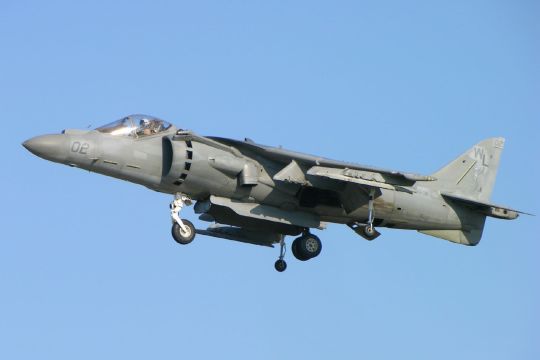
-An AV-8B Harrier II+ hovering. | Photo: D. Miller
The Italian Navy ordered two TAV-8B trainers, followed by a further order of 16 AV-8B+ to operated from the carriers Andrea Doria and Giuseppe Garibaldi. Italian Harriers were part of the nation’s commitment to the NATO campaign over Kosovo, dropping conventional and LGBs. An additional 7 aircraft were ordered in the early 200s to serve on the new carrier Cavour, with existing aircraft also upgraded to carry AIM-120s and JDAM guided bombs. Italy has ordered a force of 15 F-35B Lightning IIs to replace its Harriers.
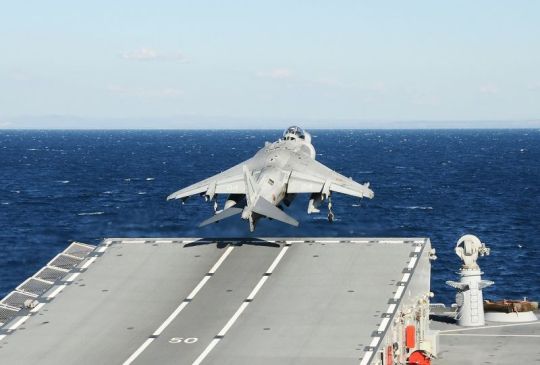
-An Italian AV-8B+ launching from the carrier Cavour’s ski jump. | Photo: Aldo Bidini
Already an operator of AV-8A Matadors, the Spanish Navy was the first international operator of the AV-8B Harrier II, ordering 12 of its own variants, known as the VA-2 Matador II. The Matadors operated from Príncipe de Asturias beginning in 1989. In 1993, an additional eight VA-2+ (the equivalent of the AV-8B+) were ordered, along with a TAV-8B trainer. In 2000, Boeing (which had absorbed McDonnell Douglas) signed a contract to upgrade a number of early model VA-2s (the number varies from 2-11) to Harrier Plus standards, allowing them to carry AIM-120 missiles. Due to budget constraints, only five of the original Matador IIs were upgraded. The Matadors were part of Spain’s commitment to Operation DENY FLIGHT, enforcing the UN’s no-fly zone over Bosnia and Herzegovina. After the Asturias was decommissioned in 2013, the Matador IIs operate from the amphibious assault ship Juan Carlos I. Spain was interested in replacing the VA-2s with F-35Bs, but has instead settled on extending the Matador’s service life, citing the cost of replacements.

-A Matador II+ over RIAT in 2019. | Photo: Airwolfhound
The first RAF Harrier II, known as the GR.5, entered service in 1987, replacing earlier GR.1 and GR.3 variants. The GR.5 differed from the AV-8B in that it had stainless steel leading edges to meet RAF bird-strike requirements, as well as in avionics and weapons. The RAF’s GR.5s were considered too immature a system to be deployed for the 1991 Gulf War, though several were dispatched to patrol the no-fly zones in 1993. Beginning in 1990 BAe began testing an upgraded Harrier II GR.7, which was broadly similar to the Night Attack AV-8B. After a successful test program 34 GR.7 were delivered through 1991, with the existing GR.5s upgraded beginning the same year. The GR.7s, hastily modified with GPS navigation, were deployed with NATO forced to the former Yugoslavia, and carried out recon and strike missions, often dropping LGBs on targets designated by SEPECAT Jaguars. Later, GR.7s were part of the UK’s commitment to the wars in Afghanistan and Iraq. Beginning in the middle 2000s, BAe began development of the GR.9 upgrade, which would improve communications, ground proximity warning and navigation systems, followed by the integration of the AGM-65 Maverick air-to-ground missile. The GR.9 upgrade also included replacement of fatigued airframe components. GR.9s were deployed to Afghanistan in 2007, allowing aged GR.7s to be withdrawn. The stresses of war and advancing age of the fleet caused the wholesale retirement of the RAF’s Harrier IIs in 2011, with their tasks being assigned to Tornado GR.4s until delivery of the F-35B Lightning.

-A Royal Air Force Harrier GR.9 conducts a combat patrol over Afghanistan, equipped with a laser-designator pod and armed with Paveway guided bombs. | Photo: USAF
#aircraft#aviation#avgeek#cold war#airplanes#airplane#cold war history#coldwar#aviation history#mcdonnell douglas#bae#british aerospace#AV-8B#av 8b#av8b#gr7#gr9#harrier gr7#harrier gr9#usmc#raf#rn#royal air force#royal navy
23 notes
·
View notes
Video
What ever happened to the RAF Harrier fleet? #1 by Alan Wilson
Via Flickr:
Other than a few examples in UK museums and technical schools, the RAF Harrier II fleet has ended up dismantled and in store for the U.S. Marines. This row of fuselages consists of seven single seat GR9s and eight two-seat T12s. They are stored in Area 23 of AMARG, Davis Monthan AFB, Tucson, Arizona. 09-2-2014
1 note
·
View note
Photo
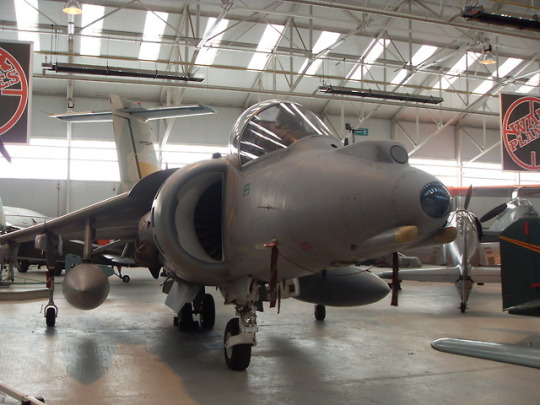
RAF Cosford Museum. A Harrier GR9 (Or AV 8B to US viewers)
Thank you viewers for the edits! :3
116 notes
·
View notes
Photo

McDonnell Douglas AV-8B Harrier II Plus aeronave de despegue y aterrizaje vertical/corto de segunda generación o V/STOL de los marines. Vlastimil Suchy. Box art Hobby Boss Se usa principalmente para tareas de ataque ligero o funciones múltiples, generalmente operadas desde pequeños portaaviones y grandes buques de asalto anfibio. El AV-8B es utilizado por el Cuerpo de Marines de los Estados Unidos. Las versiones británicas Harrier GR7/GR9 son utilizadas por Royal Air Force y Royal Navy. Las versiones también son utilizadas por los países de la OTAN: España e Italia. https://ift.tt/2NSGaIE
24 notes
·
View notes
Photo

Sixteen GR9 Harrier aircraft from the RAF and Royal Navy are pictured flying in a diamond formation to mark the retirement of the famous aircraft after 41 years of service.
Photo by Cpl Al Crowe
203 notes
·
View notes
Photo
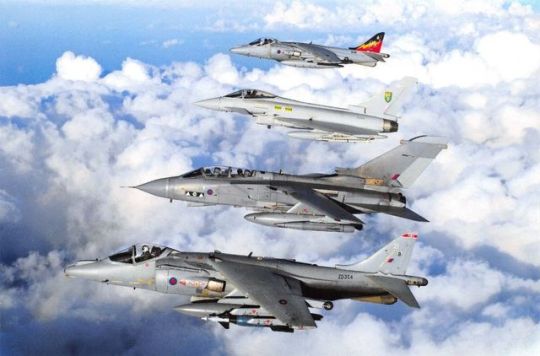
FYI: #postcard Please #Retweet Postcard RAF Fighters Harrier GR9, Tornado GR4, Typhoon F2 Flying Together 25C http://dlvr.it/Qb0X7S
21 notes
·
View notes
Note
hello! hope this isn't a bother, but what are some of your favorite fcs 25+? I'm looking to expand my horizons a little more and I think you have awesome taste so I would love to get some recs if you've got time! pretty please and thank you very much!! 💖
kjdskfnasfj thank u sm ?? it’s not a bother at all, dw !! honestly, i need to get better w/ expanding my own horizons djsnfkjs but anyway ! off the top of my head: avan jogia, john boyega, daisy ridley, tessa thompson, ludi lin, tom ellis, lupita nyong’o, zoë kravitz, joe keery, jodie comer, keanu reeves, michael b. jordan, janelle monáe, laura harrier, vanessa morgan, mahershala ali, matthew daddario, cody fern, dev patel, alicia vikander, aja naomi king, winston duke, hayley atwell, hari nef, daniel sharman, trevante rhodes, lindsey morgan, richard madden, robert sheehan, oscar isaac, adria arjona, theo james, jenna coleman, gemma chan, mishti rahman… also do ppl actually use lizzo as a fc ? bc if not, they should. i’m Obsessed w/ her rn !
there r defo more, but that’s all i can think of – i hope it helps ! ty again and i hope you have a gr9 day !! 💖

0 notes
